From Floridata
by Steve Christman
Arbutus unedo
Common
Names: Strawberry tree, arbutus, cane apples
Botanical
Family: Ericaceae, the heath Family
Description
Strawberry
tree is an evergreen broadleaf shrub or small tree with a spreading,
picturesque habit, and gray-brown bark that flakes and peels in thin
plates to reveal the reddish young bark beneath. The species can get up
to 30 ft (9 m) tall and just as wide but many of the popular cultivars
are smaller. In the southeastern US strawberry tree rarely exceeds 8 -
12 ft (2.5 - 3.7 m) in height. The leathery leaves are glossy on top,
oblong or oval with toothed margins, and 2 - 4 in (5 - 10 cm) long.
Older specimens develop attractive twisted and gnarled trunks and
branches. Here in North Florida, strawberry tree begins blooming in
autumn and continues into the winter. The small white or pinkish
blueberry-like flowers are assembled in drooping panicles about 2 in (5
cm) long. The spherical bright red fruits are warty and about 3/4 in (2
cm) inch in diameter. They take a year to ripen, and both flowers and
fruits can be present at the same time. Strawberry tree in fruit is
very showy.
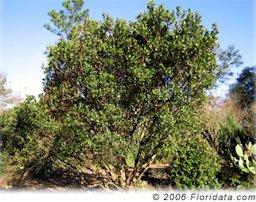
Jack
grows this dwarf variety of strawberry tree called 'Elfin King' on a
hot sunny hillside. It has grown to 12 ft (3.7 m) high by as wide in
the past 12 years.
The cultivar, 'Compacta' is smaller and
more compact than the species. 'Rubra' has deep pink flowers; 'Elfin
King' is smaller than the species to about 6 ft (1.8 m) tall and makes
a good container plant (without pruning, Jack's Elfin King is now 12 ft
(3.7 m) tall). This cultivar blooms over a long period in autumn into
winter. Arbutus X andrachnoides is a hybrid between A. unedo and A. andrachne and is a popular ornamental in Europe.
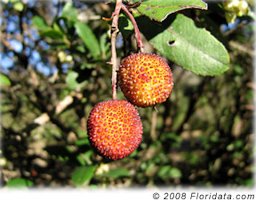
Some think the attractive (and edible but not very tasty) fruits of Arbutus unedo look like strawberries but I don't see the resemblance. Do you?
Location
Strawberry tree, Arbutus unedo
is native to Ireland, southern Europe and the western Mediterranean
region (Turkey, Greece, Lebanon) where it grows in rocky, well-drained
soils. It is a very popular ornamental in southern California.
Culture
Strawberry tree is tolerant of acidic to alkaline soils. Protect from winter winds.
Light: Strawberry tree does best in full sun to partial shade except in desert regions where more shade is necessary.
Moisture: Strawberry
tree is drought tolerant once established, and does well even in desert
regions, where it may need watering only during the autumn and winter.
Hardiness: Zones 7 - 10.
Propagation: Strawberry tree is propagated by seeds, which germinate readily, and by cuttings of half-ripe wood taken in summer or autumn.
Usage
Strawberry
tree is an excellent choice for a shrub border or woodland garden, or
even as a small specimen tree. Smaller cultivars are good in containers
or on the patio. Strawberry tree is a good choice for coastal areas
since it is salt tolerant. Prune minimally to enhance shape, but don't
try to make a hedge from this shrub. Strawberry tree does best in
Mediterranean climates, with cool, wet winters and mild, dry summers.
It doesn't do as well in continental climates, with hot, humid summers
and cold winters. Avoid using near pool and patio as heavy fruit set
can make a mess on a walkway or patio (this isn't a problem for the
'Elfin King' cultivar which fruits only sparingly).
The bark of
strawberry tree has been used in tanning leather. The fruit is edible,
but that of some ornamental cultivars tends to be mealy and tasteless.
In Portugal, strawberry tree fruits are fermented to make a strong
tasting wine known as medronho. The fruits also are used to make
preserves.
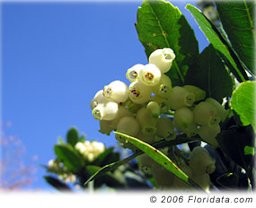
Strawberry tree's urn-shaped flowers resemble those of another member of the Ericaceae family, the blueberry (Vaccinium ashei).
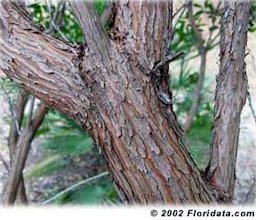
The handsome reddish-brown bark covering the strawberry tree's gnarled branches makes for a rugged, masculine appearance.
Features
Blooming
and fruiting in autumn, strawberry tree makes an unusual specimen
shrub, showing pretty red fruits and little pinkish flowers through its
shiny greenery when most shrubs are going dormant. Older specimens are
especially attractive with their shredding gray-brown bark and twisted,
gnarled trunks.
The related Pacific madrone (A. menziesii) occurs in California and Oregon.
Strawberry
tree is recommended by the California Invasive Plant Council as a
suggested landscape substitute for often-used invasive species like
Brazilian pepper (Schinus terebinthifolius).
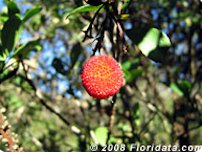 | 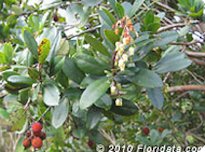 | | Strawberry tree fruits | Strawberry tree | 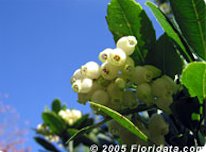 | 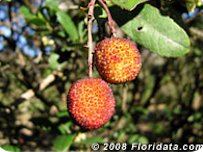 | | Strawberry tree flowers | Strawberry tree's strawberry-like fruits |
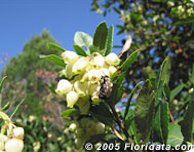 | | Strawberry tree flowers |
|
|
Bibliography
Christman,
Steve. "Arbutus unedo." Floridata,
no. 634, Published 29 Feb. 2000; Updated 31 Dec. 2002, 26 Nov. 2003, 5
Jan. 2006, 12 Dec. 2008, 15 Oct. 2010, 30 Oct. 2011, floridata.com/plant/634.
Accessed 26 June 2022.
Published 26 June 2022 LR
|








